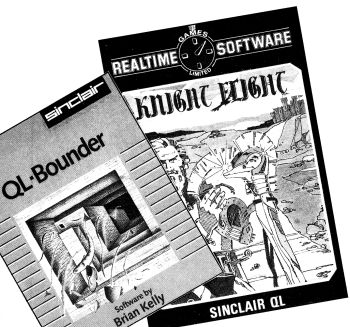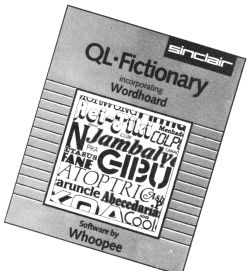| QLink |
THE DEATH of the QL is imminent! cry the prophets of doom who like to think the demise of the much maligned machine is just around the corner.
However, the QL is not sunk yet. Despite the rumours, I have it on good authority that the official Sinclair Research sales figure is 150,000 which is a marked increase on sales of 70,000 six months ago.
I would be more conservative in my estimates, but from talking to retailers, such as Transform, East London Robotics and Digital Precision, it seems that sales have breached the 100,000 mark since the price dropped to £199.
An estimated 20 per cent of those units is going abroad where the market is substantial. All I can say is any more advances on 100,000? Answers on a postcard please.
The truth is, however, that QL sales and support are more healthy than at any time during its troubled life. Sinclair has released six products, ranging from arcade games to an upgraded version of Talent's GraphiQL. Bounder is a levels and ladders game with 59 locations. You must collect as many objects as you can, and for every object you pick up you get an extra life.
QL Jabber is described as a classic zap 'em game with 26 screens full of disease and potential death. You must fight off the deadly viruses and bacteria, protecting your body with packets of antibiotics. Quboids is similar in concept, but consists of four platforms on which you are constantly under attack from manic monsters. To stop them, dig holes which they should fall down.
On a more serious level QL Macro Assembler, produced for Sinclair by those Cambridge GST giants, makes assembly of 68008 machine code easy with full screen editor, and a macro library which allows you to tap into the heart of QDOS.
QL Paint is a souped-up version of GraphiQL, produced for Sinclair Research by Glasgow software house Talent. The package uses icons and drop down windows, turning the QL into a coloured Apple Macintosh. There are 50 individual shape and pixel manipulation commands which can be combined to produce 4,000 graphics operations.
Sinclair is also releasing some serious games. QL Classic Adventure may be familiar to those who own a Spectrum. It is a two-program package which includes The Adventure and Mordon's Quest, both written by Abersoft from the original Crowther and Woods adventure. They are set in a fantasy world of dwarfs, serpents, and strange objects.
QL Fictionary is for those who like word puzzles. It has an 18,000 word dictionary which is used to provide two types of game. The first is Call my Bluff where you are given
 four definitions of a randomly selected word, you must then select the correct definition. The other game, Word Hoard sets up anagrams for you to solve.
four definitions of a randomly selected word, you must then select the correct definition. The other game, Word Hoard sets up anagrams for you to solve.
All the packages will be available from computer shops or on order from WH Smith and Dixons.
Several independents have brought out complex games which use the full resources of the QL memory. One such product is QL Adventure, a game from Optimus Software, a new software house. It concerns the trials and tribulations of the troubled machine and contains a mixture of text and reasonably good static location graphics.
If you are more interested in arcade graphics but prefer strategy games, then Knight Flight from Realtime Software will have you in fits of ecstasy.
Written by the programmers of Starstrike - available for the Spectrum - it uses full colour sprites to depict a knight's quest for glory over a shifting landscape. For £14.95 it represents good value for money and can be obtained from Realtime Games Software Ltd, Leeds.
Tasman, the company responsible for the Tasword wordprocessor on the Spectrum, has produced two print utilities for the QL.
Tascopy adds new commands to SuperBasic which will copy a screen through the RS232 interface onto an Epson compatible printer. It can also be used to print a specified window and create poster size prints which can be put onto several sheets of paper.
Tasprint QL is called The Style Writer by Tasman. It includes a screen editor which can be used to modify files which have been created by word processor programs, or your own Basic. These files can then be printed in a number of fonts using special control codes.
Software launch of the year, so far, is from Digital Precision which has just released four new packages.
Supercharge is the major release. It is a powerful SuperBasic compiler which turns the high level language into machine code, using a procedure which is simpler than any other compiler on the market.
It will compile all SuperBasic commands including graphics, sound, procedure, and loop instructions using four passes. When the package is booted a set of SuperBasic extensions,
 dealing with mufti-tasking, are loaded. You can then load in your own SuperBasic listing and merge Supercharge with it, ready for compilation.
dealing with mufti-tasking, are loaded. You can then load in your own SuperBasic listing and merge Supercharge with it, ready for compilation.
The compiler automatically saves compiled code to microdrive and you can run any of them as tasks, adjusting their QDOS priorities using the SuperBasic extensions.
The package can, and has been used by professional software companies for a one-off payment of £250. Users include Eidersoft, Talent, and Strathclyde University.
QL Astrology, also from Digital Precision, is the most interesting launch of the month. It provides accurate birth charts and correlates aspects using the Placidus and Equal House systems. New versions of both products are soon to be released, and next month's Sinclair User will include an in depth review of Supercharge.
Those who dislike icon driven programs have argued that they cannot understand what the icons mean. WD Software, a relative newcomer to the QL market, has got around the problem by producing a front end utility which uses not icons, but words.
JOSS - Joystick Operated Software System - can be operated from the keyboard, freeing you from typing in long file handling commands such as COPY ... TO ...
It uses menus of SuperBasic commands which can be selected and implemented using a cross-hair cursor. Also included is a realtime clock and a facility which allows you to check on the files stored on microdrive and disc.
Two versions are available, one for microdrive and the other for disc. The disc version can access microdrive but the microdrive version will not access disc.
The screen display initially looked a little confusing but, with the aid of the tightly worded manual I could see that the utility would be of some use to people who do not like typing in long commands.
On the other hand, Q-Calc, from Psientific Software, is utterly useless unless you want to turn your QL into a glorified calculator. Not surprisingly, the main display is of a digital calculator which has all the functions one would expect of a digital calculator.
It can be used to add, subtract, multiply and divide. It even has memorise and recall buttons which are controlled from the keyboard. Hmmm, interesting, but certainly not worth its exorbitant price tag.
Whatever the size of your company, if you have any QL products which you want reviewed, or tips for fellow QL users, or perhaps queries about your machine, send them to John Gilbert, QLink, Sinclair User, London.